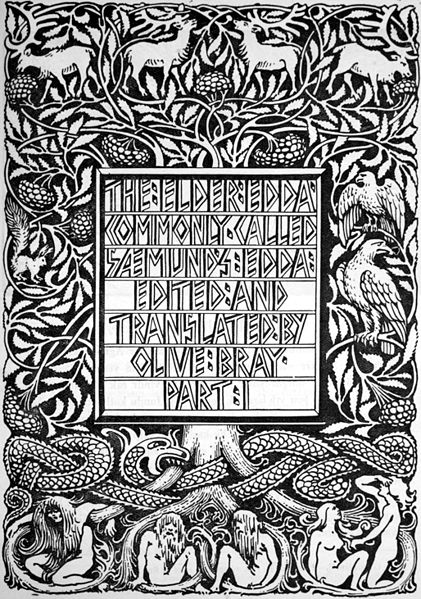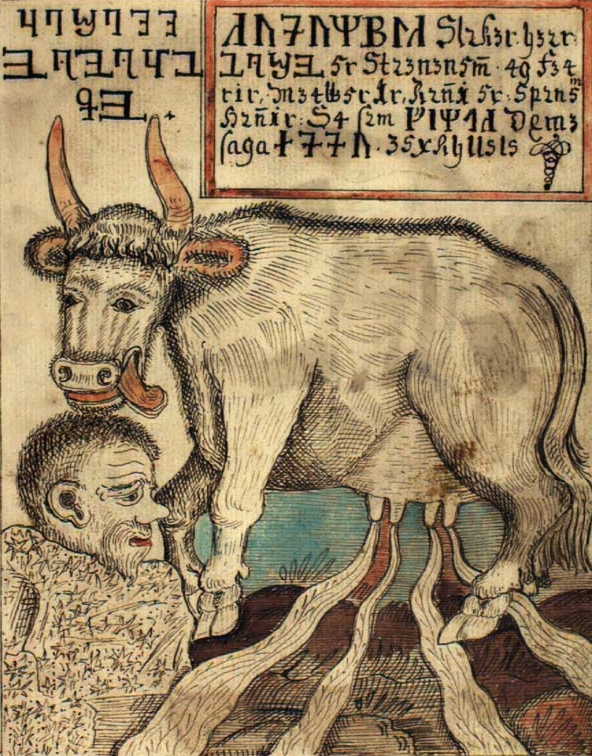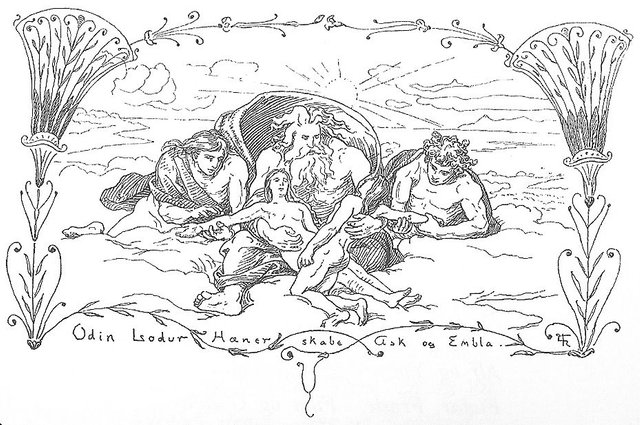Norse Mythology - The Creation of the World
Creation of the word in the Norse Mythology is covered in two books: The Poetic Edda and the The Prose Edda. The Poetic Edda is the older of the two, it is a collection of Old Norse poems. Most of the poems are collected in the Codex Regius, the Icelandic medieval manuscript. The Prose Edda is an Old Norse work of literature written in Iceland. It is assumed to have been written or compiled by Snorri Sturluson, Icelandic scholar, and historian from the early 13th century.
The two Edda’s agree on many topics, but sometimes they diverge. In this article, I will cover the stories from both Edda’s about the creation of the world. In places where they diverge, I will cover both of the stories.

The title page of Olive Bray's English translation of Codex Regius, illustrated by W.G. Collingwood
Ginnungagap, Muspelheim and Nilfheim
Before there were world and life there was the gaping abyss called Ginnungagap, the primordial void. South of Ginnungagap was Musphelheim (Múspellsheimr) the realm of primordial fire and heat. North of Ginnungagap was Nilfheim the realm of primordial ice and cold.
In the foggy realm of Nilfheim is Hvergelmer, the spring from which all rivers come. One of the three primary roots of the cosmic tree Yggdrasil extends into the spring. In Hvergelmer lives an uncountable number of snakes and the dragon Níðhǫggr who gnaws on the root of Yggdrasil from below.

The dragon Niðhöggr gnawing the roots of Yggdrasill - an illustration from a 17th-century Icelandic manuscript
The Sun and all stars come from the burning realm of Muspelheim. The realm is inhabited by Eldjöntar (fire giants) and ruled by Surtr and his consort Sinmara. Surtr guards the frontier of Mupellhein, holding his flaming sword which burns brighter and hotter than the Sun. He is prophesied to lead his hosts in the battle against the Æsir and the Vanir during the events of Ragnarök. The flames that he brings forth will burn all realms.
The northern parts of Ginnungagap were turned towards Nilfheim; the colds of Nilfheim spread there filling it with masses of ice and rime. The southern parts of Ginnungahap were ignited by the sparks and burning winds which blew from Muspelheim. In the middle, the breath of heat met the rime, and thus the creation began.
Ymir and the begining of creation
Eleven icy rivers of Nilfheim streamed into Ginnungagap; they came far from their source and venomous yeast which flowed with them froze and flowed no more. Thus hardened, the frozen venom blocked the stream of the rivers and layers of ice were added upon hardened venomous yeast. The layers were pushing the yeast ever further towards the middle of Ginnungagap. Once the ice got close enough to the middle, heated blasts from Muspelheim started melting it. First, the venom melted and venomous drops quickened into life in form of the first Frost giant – Ymir, called Aurgelmer by the other frost giants.
Yimir fell asleep and sweated, as he sweated under his left armpit grew a male and a female. While Ymir slept his two feet mated and begat a six-headed frost giant. From those, the rest of the frost giant race descended.
Rime melted next and from the rime, a primeval cow Auðumla sprang. From Auðumla’s udders, four streams of milk ran and she nourished Ymir with that milk. Auðumla was in turn nourished by licking the salty ice-blocks. As she licked the ice, the ice melted. In the evening of the first day hair of a man came forth from the ice. On the second day, the head of the man was found beneath the ice, and on the third day, the whole man was there. The man was Búri, the first of the Æsir Gods.

Búri is licked out of a salty ice-block by the cow Auðumbla - an illustration from the 18th-century Icelandic manuscript, now in the care of the Danish Royal Library
The creation of the world
Búri was great and mighty, and his features were fair. He had a son who was also mighty and fair, his name was Borr. Borr married a frost giantess Bestla, a daughter of the giant Bolthorn (Þrúðgelmir - “Strength Yeller). The couple had three sons; the first of the sons was Odin who later became the leader of Æsir tribe of gods. His two younger brothers were Vili and Vé.
The three brothers slew the frost giant Ymir. When he fell, so much blood flowed that it drowned whole race of the frost giants. Only one of the giants managed to save himself. He was Bergelmir, son of Bolthorn.
Poetic and prose Edda are conflicting on how Bergelmir survived. In the Poetic Edda he was laid in the lúðr (a wooden box), which could refer to a coffin or a chest. In the Prose Edda he escaped the drowning by going on board of his ark with his wife. Both Edda’s agree on the point that new race of the frost giants descended from him.
Sea nor cool waves nor sand there were;
Earth had not been, nor heaven above,
But a yawning gap, and grass nowhere.
The third stanza of the poem Völuspá from the Poetic Edda
Another topic that both Edda’s agree on is what happened with slain Ymir and sons of Borr. Odin, Vili, and Vé took the body of Ymir and carried it into the midst of Ginnungagap, where they made earth from his flesh. From his blood, they created oceans and lakes which held the earth together. His bones were turned into mountains, and of teeth and those bones that were broken stones and pebbles were made. When the Earth was made they took his skull and raised it over the Earth to serve as the sky. Under each corner of the skull, they set a dwarf to hold it. The names of the four dwarfs were: Austre (East), Vestre (West), Nordre (North), Sudre (South). They then took his brain, made the clouds out of it and put them into the sky. From his hair, they created the trees. When that was done they took the loose sparks that had been cast out from Muspelheim and placed them in heaven, both above and below, to be stars and give light to the Earth. Some of the sparks were set in place, while others were set to move, but three brothers shaped their course. From that time, days and years were reckoned.
The creation of humans
This is another of the topics on which the two Edda’s diverge. The Prose Edda states that Bor’s sons went along the sea-strand and found two trees, from those trees they created man and a woman and named them Ask and Embla. Odin gave them life and spirit; Vili endowed them with the reason and the power of motion; Vé bestowed upon them speech, hearing, and sight.
In Völuspá, the first poem of the Poetic Edda, two different gods accompany Odin: Hœnir, Lóðurr. They found Ask and Embla which were capable of little as they had no soul, senses or motion. The three gods bestowed the three gifts upon them. Odin gave them soul, Hœnir gave them the sense, and Lóðurr gave them heat and goodly hue.
Heat nor motion, nor goodly hue;
Soul gave Othin, sense gave Hönir,
Heat gave Lothur and goodly hue
The seventeenth stanza of the poem Völuspá from the Poetic Edda
In Völuspá, the stanza preceding the creation of humans provides a catalog of dwarfs (dwarfs were created from blood and bones of Ymir). Völuspá also mentions that human forms were created from earth. Dwarfs were crafting things made of earth in time before humans; which could mean that dwarfs created forms of humans and the three gods gave them life.

Odin, Hœnir and Lóðurr give life to Ask and Embla - Published in Gjellerup, Karl (1895)
In both Edda’s, gods used Ymir’s eyebrows to create burg within the ocean and around the earth. The burg was called Midgard and given to humans to dwell in. The purpose of the burg was to protect humanity from the frost giants, who were given land on the outer strand of the ocean to dwell in.
Asgard, Æsir and Bifrost
In the middle of the world, Odin, Vili, and Vé created another burg for themselves – Asgard. In Asgard, Odin seated himself in his high-seat – Hliðskjálf; from there Odin saw over the whole world and knew all things that he saw.
Norse mythology tells us about the two earths, the feminine Fjörgyn, and the masculine Fjörgynn. With feminine earth, he had his first son, Asa-Thor. Thor was given force and strength of the earth, with which he conquers and rules all things easily.
The daughter of the masculine earth was Frigg, Odin’s wife. From Odin’s and Frigg’s offspring, all other Æsir gods descend. As the father to gods and humanity, Odin is known as Alfather.

Yggdrasil - Art from the English translation of the Prose Edda from 1847, by Oluf Olufsen Bagge
The daughter of a giant Norfe was swarthy and dark and her name was Night. With her husband Delling (Daybreak), who was of the Æsir race, she had a son. The son was light and fair as his father and his name wes Day. Odin took Night and day; he gave them two horses Hrimfaxe and Skinfaxeand, and two carts. He then set them up in heaven to ride around the Earth in 12-hour turns.
After Night and Day were set in heaven, gods constructed Bifrost; the three-colored bridge that connects earth and heaven. The bridge is created with more skill and craft than any other structure. The humans can occasionally glimpse the bridge, and they call it rainbow. With the creation of Bifrost, the creation of the world was completed.
Sources
- The Poetic Edda
- The Prose Edda - Snorri Sturluson
- Wikipedia
I have been waiting for this since you joined Steemit and finally, I got it 💚

Hahaha, I hope you are satisfied with the post :D
Now that I have opened the series, I will try to deliver one post about the Norse mythology every week ;)
Only one per week??? Buuuuuu... We want more! :D
It takes time to write one of these and find fitting art for the posts :)
What to say really brother. I think I learned even more from your presentation tonight. It is one thing to read your posts but the other to hear you speak. You have a deep knowledge of this subject because some of the stuff you said in live promotion is not even in this post.
We could really feel how passionate you are about the subject. You can feel it in words, but hearing somebody speaking about is a totally different story. Amazing job on your post and even more amazing job presenting it.
Keep up with the amazing post you have been posting. Thank you for sharing. Have a great day. :)
Never really knew much about the norse mythology, now I have a handful of information and my head hurts.
thanks for sharing
Hahaha, come back next week for another headache :P
now you are just being mischievous.... haha
bring it on
Wow that is indeed in-depth and thorough. I learned some of it as a kid but forgot half, thanks for bringing it back. And for adding more detail. :)
I am glad you like it, it hasn't been easy to find a lot of people who are willing to read posts this long :)
You had me at Norse Mythology and I knew I had to read it. Brings so much memories of me in high school reading the different mythologies and I really enjoyed Norse with its story of the Aesir and Ragnarok.
I picked up an old book of James Lovegrove which was a modern retelling of it. It had mixed reviews but I loved it.
I was also reading about various mythologies during my high school, mostly Greek and Egyptian as the sources for those were easiest to find.
Norse is among my favorites now, and I will continue to write about it while I am exploring other mythologies and deciding which one I will write about next. I will certainly write about Slavic, but I am saving it for the time when I have more followers, as it is my favorite. :D
I might also write about Japanese but at the moment I don't know enough about it to create high quality content.
Thanks for stopping by :)
So detailed
I consider Norse Mythology, along with Egyptian and Greek, my favorite! Thank you for sharing.
Mine favorites so far are Slavic and Norse :) There will be a lot more posts here from both of those :)
I got to say that I have absolutely no clue about mythology and everything connected to that, but also I got to admit that your commitment and effort you invest in such posts are amazing!
You can almost literally see your love about that and that's what we need to grow and this community to grow. Keep your work man and I wish you all the best :)
Thank you for your encouragement!
I had a lot of time without reading about this, I almost did not remember, but I ran into your publication and remembered a bit. I like your content, you have my support. regards
Thank you for the support!
Congratulations! This post has been chosen as one of the daily Whistle Stops for The STEEM Engine!
You can see your post's place along the track here: The Daily Whistle Stops, Issue #90 (3/31/18)
The STEEM Engine is an initiative dedicated to promoting meaningful engagement across Steemit. Find out more about us and join us today.
<3